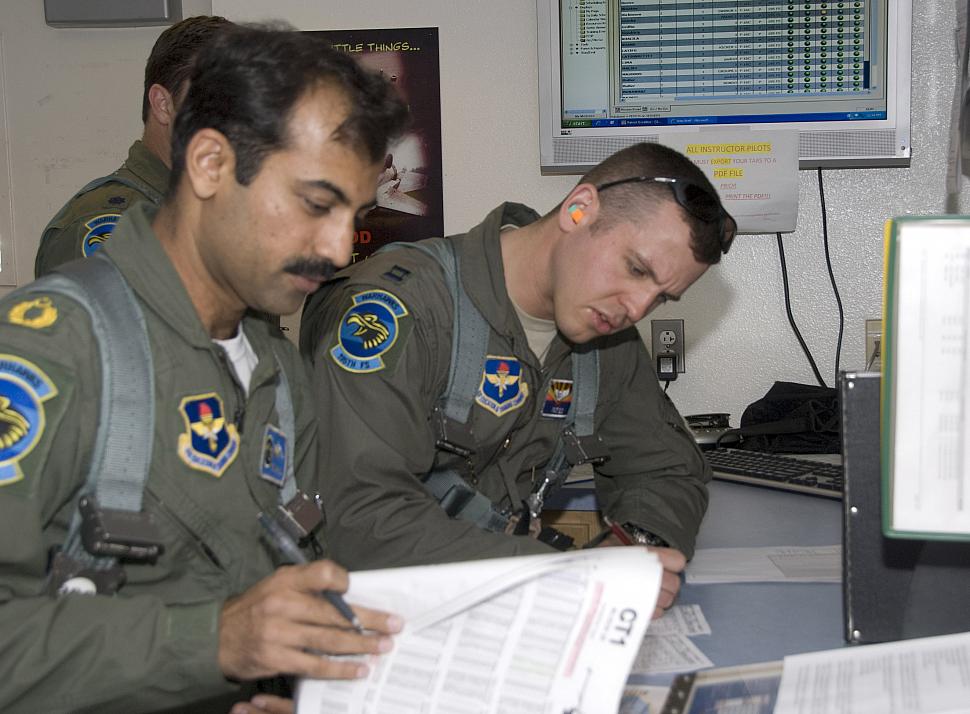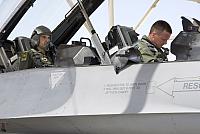Fighter Jet News
F-16 Fighting Falcon News
F-16 training bolsters U.S.-Pakistan relations
May 4, 2010 (by
Maj. Gabe Johnson) -
Pakistan's air force soon will upgrade its 30-year-old fleet of F-16 Fighting Falcons, and the pilots charged with flying more capable fighters are ready to handle the new technology after training with the Arizona Air National Guard.

Eight Pakistan Air Force pilots, each experienced in the F-16A/B, recently learned to fly the newer C/D model aircraft at the 162nd Fighter Wing, the international F-16 training unit at Tucson International Airport. They were honored at a graduation ceremony on May 4.
They are the first from their country to train in the United States since 1983 when the last class of Pakistani pilots trained at Luke Air Force Base, Ariz.
"This graduation is historic for U.S.-Pakistan relations," said Pakistan Air Force Wing Commander Ghazanfar Latif, a 12-year F-16A pilot. "For Pakistan, our air force is gaining capabilities that it has needed for the last decade; capabilities that are critical to ongoing operations in Pakistan's war on terror."
The new planes purchased by the Pakistani government, block 52 versions of the multi-role fighter, are far more advanced than the older A-model versions and will allow pilots to conduct operations at night and greatly enhance their use of precision munitions.
The first four of the 18 total purchased are scheduled for delivery June 26 to Shahbaz air base in south-central Pakistan. The rest will be delivered on a staggered schedule throughout this year. In addition, their existing fleet will undergo a mid-life update in 2011 designed to upgrade cockpits and avionics to match the F-16C/D.
In preparation for the June delivery, the eight pilots and their families will have spent 10 months in the United States navigating the upgrade training pipeline.
They spent two and half months reviewing military aviation terminology at the Defense Language Institute at Lackland Air Force Base, Texas, and seven months in flight training at Tucson International Airport. Since the C/D-models used for training in Tucson are block 25 F-16s, they will next undergo two weeks of additional block 52 instruction before returning to Pakistan.
"Even though they're flying block 25s here, they will still be able to operate their block 52s back home. When they leave here they will get training from Lockheed Martin in Fort Worth, Texas, on the differences," said Lt. Col. Kelly Parkinson, 195th Fighter Squadron commander. "The two blocks fly the same; it's essentially the employment of weapons that makes the difference."
The bulk of their flight training in Tucson included a transition course from the F-16A/B to the F-16C/D, flight lead upgrade training and instructor pilot certification.
"We're training these eight pilots so they can return home and be instructors themselves and teach others to fly the new F-16s," said Colonel Parkinson, a 22-year fighter pilot.
"I think the training here is very well organized and tailored to our needs, also the standards here are very high," said Latif. "This is going to make a big difference because we do not have the capability to make precision engagements at night with A-models. Everybody understands that collateral damage is a big factor and the sensors on the C-model will help us carry out precision engagement and close air support."
With so much to learn, the students flew a rigorous schedule of five flights per week. The average student tempo is closer to three per week.
"The radar, datalink and other avionics help create the big picture of what is going on around you. There's lots of information to process in the C-model, so you have to prioritize all of the input you are getting," said Squadron Leader Yasir Malik. "But these instructors know what they are doing and they are good teachers."
Maj. Windy Hendrick, a flight commander and 13-year F-16 pilot, has instructed students from all over the world. She said she and her fellow instructors learned a great deal about their Pakistani counterparts.
"They are all experienced pilots with 500 to 1,800 fighter hours in the F-16, and the majority of that time is combat hours in the fight against extremists," she said. "They are very humble and don't talk about their experience, but the more we learn about them and all they've done it makes us proud to be their instructors."
"They are very dedicated, hard working and they have great attitudes. Their presence in the squadron has been a real pleasure."
When flying over the military ranges of Southern Arizona, Pakistan's pilots had experienced instructors like Hendrick to guide them; but back on the ground they relied on the unit's international military student office (IMSO) for help with housing, transportation, documentation and adapting to American culture.
"We could not ask for more help from the IMSO office. They came to San Antonio to meet us before we came to Tucson to help us start our move," said Squadron Leader Malik. "They went to see apartments in Tucson to help us find living arrangements, and they set up many trips all over the state. We saw so many places that we would never have found on our own."
"We would have been more confused with trying to find a place to live and get adjusted if it weren't for IMSO."
It's unclear if more student pilots from Pakistan will train in Tucson; however, according to Colonel Parkinson, the 162nd stands ready.
"Training capable fighter pilots for our partner-nation air forces and fostering relationships in the world-wide F-16 community is what we do. We will continue to help train Pakistan's pilots whenever we're needed," he said.

PAF Squadron Leader Azman Khalil, left, goes over flight information with Capt. Andy Wittke, an instructor pilot at the 162nd FW, before a training mission on April 27th, 2010. Khalil and seven other Pakistani pilots graduated from F-16C/D upgrade training at Tucson IAP on May 4th, 2010. [USAF photo by MSgt. Dave Neve]
They are the first from their country to train in the United States since 1983 when the last class of Pakistani pilots trained at Luke Air Force Base, Ariz.
"This graduation is historic for U.S.-Pakistan relations," said Pakistan Air Force Wing Commander Ghazanfar Latif, a 12-year F-16A pilot. "For Pakistan, our air force is gaining capabilities that it has needed for the last decade; capabilities that are critical to ongoing operations in Pakistan's war on terror."
The new planes purchased by the Pakistani government, block 52 versions of the multi-role fighter, are far more advanced than the older A-model versions and will allow pilots to conduct operations at night and greatly enhance their use of precision munitions.
The first four of the 18 total purchased are scheduled for delivery June 26 to Shahbaz air base in south-central Pakistan. The rest will be delivered on a staggered schedule throughout this year. In addition, their existing fleet will undergo a mid-life update in 2011 designed to upgrade cockpits and avionics to match the F-16C/D.
In preparation for the June delivery, the eight pilots and their families will have spent 10 months in the United States navigating the upgrade training pipeline.
They spent two and half months reviewing military aviation terminology at the Defense Language Institute at Lackland Air Force Base, Texas, and seven months in flight training at Tucson International Airport. Since the C/D-models used for training in Tucson are block 25 F-16s, they will next undergo two weeks of additional block 52 instruction before returning to Pakistan.
"Even though they're flying block 25s here, they will still be able to operate their block 52s back home. When they leave here they will get training from Lockheed Martin in Fort Worth, Texas, on the differences," said Lt. Col. Kelly Parkinson, 195th Fighter Squadron commander. "The two blocks fly the same; it's essentially the employment of weapons that makes the difference."
The bulk of their flight training in Tucson included a transition course from the F-16A/B to the F-16C/D, flight lead upgrade training and instructor pilot certification.
"We're training these eight pilots so they can return home and be instructors themselves and teach others to fly the new F-16s," said Colonel Parkinson, a 22-year fighter pilot.
"I think the training here is very well organized and tailored to our needs, also the standards here are very high," said Latif. "This is going to make a big difference because we do not have the capability to make precision engagements at night with A-models. Everybody understands that collateral damage is a big factor and the sensors on the C-model will help us carry out precision engagement and close air support."
With so much to learn, the students flew a rigorous schedule of five flights per week. The average student tempo is closer to three per week.
"The radar, datalink and other avionics help create the big picture of what is going on around you. There's lots of information to process in the C-model, so you have to prioritize all of the input you are getting," said Squadron Leader Yasir Malik. "But these instructors know what they are doing and they are good teachers."
Maj. Windy Hendrick, a flight commander and 13-year F-16 pilot, has instructed students from all over the world. She said she and her fellow instructors learned a great deal about their Pakistani counterparts.
"They are all experienced pilots with 500 to 1,800 fighter hours in the F-16, and the majority of that time is combat hours in the fight against extremists," she said. "They are very humble and don't talk about their experience, but the more we learn about them and all they've done it makes us proud to be their instructors."
"They are very dedicated, hard working and they have great attitudes. Their presence in the squadron has been a real pleasure."
When flying over the military ranges of Southern Arizona, Pakistan's pilots had experienced instructors like Hendrick to guide them; but back on the ground they relied on the unit's international military student office (IMSO) for help with housing, transportation, documentation and adapting to American culture.
"We could not ask for more help from the IMSO office. They came to San Antonio to meet us before we came to Tucson to help us start our move," said Squadron Leader Malik. "They went to see apartments in Tucson to help us find living arrangements, and they set up many trips all over the state. We saw so many places that we would never have found on our own."
"We would have been more confused with trying to find a place to live and get adjusted if it weren't for IMSO."
It's unclear if more student pilots from Pakistan will train in Tucson; however, according to Colonel Parkinson, the 162nd stands ready.
"Training capable fighter pilots for our partner-nation air forces and fostering relationships in the world-wide F-16 community is what we do. We will continue to help train Pakistan's pilots whenever we're needed," he said.
Courtesy of 162nd Fighter Wing Public Affairs
Additional images:


Lt. Col. Alex Wilson, right, an instructor pilot at the 162nd FW, and PAF Squadron Leader Shirjil Kahn, prepare for an F-16D training flight at Tucson IAP on April 27th, 2010. During seven months of training here, eight Pakistani fighter pilots learned how to train others to fly their air force’s newest F-16 Fighting Falcons. [USAF photo by MSgt. Dave Neve]
Related articles:
Forum discussion:
Tags
- Pakistani pilots complete training in the US (2010-05-02)
- Peace Drive I - First F-16 unveiled (2009-10-13)
- Lockheed gets $144 million deal for Pakistan F-16s (2006-12-06)
- F-16 Fighting Falcon news archive
Forum discussion:
- Start a discussion about this article in the F-16.net forum.
Tags
